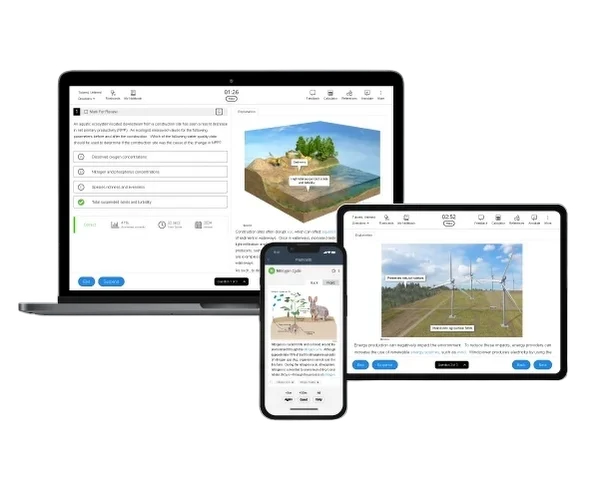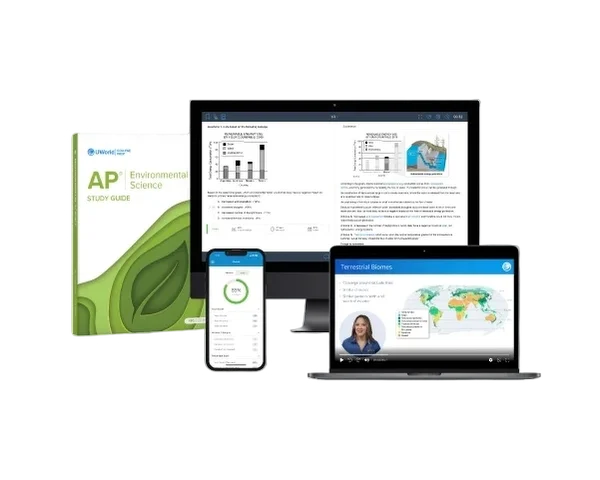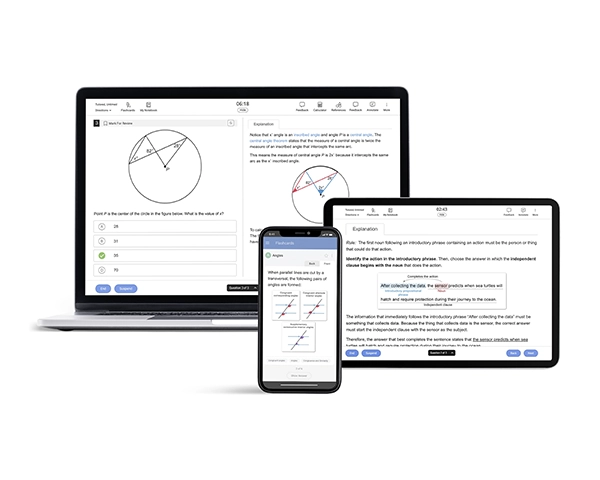The AP Environmental Science exam consists of 2 sections: Section 1 is multiple-choice questions and Section 2 is free-response questions). Both sections allow you to use a four-function, scientific, or graphing calculator.
| Section | Question Types | No. of Questions | Time Per Section | Exam Weight |
|---|---|---|---|---|
| Section I | Multiple-choice questions (MCQs) | 80 | 1 hour 30 mins | 60% |
| Section II | Free-response questions (FRQs) | 3 | 1 hour 10 mins | 40% |
Beat the Clock!
If a question feels tricky, don’t let it hold you back. Mark it, move on, and keep your momentum. You’ll save time to confidently tackle the rest and revisit it later.
Our APES Study Guide, available in digital and print formats, offers a step-by-step breakdown of all topics with easy-to-understand explanations!
AP Environmental Science Exam Format
The AP Environmental Science exam comprises 2 question types, MCQs and FRQs. These questions may appear as standalones or in sets, and some may be accompanied by visuals. Let’s dive into each question type in detail.
Multiple-Choice Questions
Section 1 of the APES exam format accounts for 60% of your total exam score. It consists of 80 MCQs to be answered in 1 hour and 30 minutes. These questions are a mix of standalone and set-based formats. While most of the questions will be standalone, you will find approximately 9 set-based, including:
- 3-4 sets include quantitative data, such as data tables, charts, or graphs. These questions mostly evaluate Science Practice 5 (Data Analysis), and can also check your knowledge of other Science Practices 1, 4, 6, or 7 (Concept Explanation, Scientific Experiments, Mathematical Routines, or Environmental Solutions).
- 3-4 sets include qualitative information, such as models, representations, or maps. These questions assess your understanding of Practice 2 (Visual Representations) but can also evaluate Science Practices 1, 4, or 7 (Concept Explanation, Scientific Experiments, or Environmental Solutions).
- 2 sets include text-based sources. These questions analyze Science Practices 1, 3, 6, or 7 (Text Analysis, Concept Explanation, Mathematical Routines, or Environmental Solutions).
The MCQ section will have questions from the 9 units you learn through the APES course. However, certain units are given more weight in the MCQ section, and you will get more questions from them. The table below lists each unit and its respective weight:
| Units | MCQ Section Weight |
|---|---|
| Unit 1: The Living World: Ecosystems | 6-8% |
| Unit 2: The Living World: Biodiversity | 6-8% |
| Unit 3: Populations | 10-15% |
| Unit 4: Earth Systems and Resources | 10-15% |
| Unit 5: Land and Water Use | 10-15% |
| Unit 6: Energy Resources and Consumption | 10-15% |
| Unit 7: Atmospheric Pollution | 7-10% |
| Unit 8: Aquatic and Terrestrial Pollution | 7-10% |
| Unit 9: Global Change | 15-20% |
There is no penalty for incorrect answers on the MCQ section. Don't worry if you're not sure about an answer for 1 of the multiple-choice questions. It's a good idea to guess because you have a 25% better chance of getting a point than scoring nothing!
Our step-by-step guide on how to approach AP Environmental Science multiple-choice questions will help you do just that!
Free-Response Questions
Section 2 of the APES exam format consists of 3 free-response questions, which you complete within the BluebookTM, the digital platform used for the exam. You have 1 hour and 10 minutes to complete this section. It is worth 40% of your total exam score. There are 3 broad FRQ types in this section:
- Question 1 requires you to design an investigation based on an authentic environmental scenario depicted by a model/visual representation or quantitative data.
- Question 2 requires you to analyze an environmental problem and come up with a solution based on an authentic environmental scenario illustrated by a model/visual representation or quantitative data.
- Question 3 requires you to analyze an environmental problem and provide a solution by doing calculations based on an authentic environmental scenario.
Our expert guide on how to answer AP Environmental Science free-response questions is here to help!

What Is Tested on the APES Exam?
In addition to the question types, it's important to understand the skills and topics tested on this exam. The APES exam evaluates your knowledge of environmental concepts and how they can be applied as solutions to real-world problems. The exam tests students on 2 components:
-
Science Practices
Science practices are essential for understanding and applying environmental science concepts. Students are expected to use these practices and skills when answering exam questions. You need to master the following 7 science practices for the MCQ and FRQ sections of the APES exam.
Science Practice MCQ Section Weight FRQ Section Weight Practice 1: Concept Explanation 30-38% 13-20% Practice 2: Visual Representations 12-19% 6-10% Practice 3: Text Analysis 6-8% Practice 3 is not explicitly assessed in the free-response section. Practice 4: Scientific Experiments 2-4% 10-14% Practice 5: Data Analysis 12-19% 6-10% Practice 6: Mathematical Routines 6-9% 20% Practice 7: Environmental Solutions 17-23% 26-34% Note that questions related to science practices with higher weights will appear more frequently on the exam. For example, you're likely to see more questions related to Practice 1 in Section 1 and Practice 7 in Section 2. These weightings will help you prioritize your study efforts and create an effective plan based on your strengths and weaknesses.
-
Course Content
The APES course is structured around 4 overarching Big Ideas and 9 study units. A thorough understanding of the course content is essential for answering questions correctly and earning a strong APES score. If you're planning to take the APES course or exam, it is crucial to familiarize yourself with the full curriculum.
- Our guide to the AP ES CED has all the information you need.
- Our AP Environmental Science Online Course has everything you need to master the exam, including expert practice questions and study guides!
How Is the APES Exam Scored?
The AP Environmental Science exam is graded on a scale of 1 to 5. APES scores of 3 or higher are typically required for advanced placement and/or college credit. Since each college has its own credit requirements, it is a good idea to check the AP credit policy of your prospective colleges well ahead of time.
Double-Check Your Units!
Ensure the units in your calculations and final answers are correct. Proper units keep your work accurate and help you avoid losing points for minor mistakes.
Will the AP Environmental Science Exam be Administered through Paper or Digital Mode?
The AP Environmental Science exam is entirely digital, with students answering MCQs and FRQs using the Bluebook testing app. All responses are automatically submitted once the exam concludes.
Now that you understand the APES exam structure, it's time to set your goals and get ready. You can use our AP Environmental Science practice test to find hundreds of exam-like questions and detailed answer explanations. Not just this, our performance indicators will help you improve on your weak areas and achieve your target score. And the best part? There's a free trial!

References:
- AP Environmental Science. (n.d.). apcentral.collegeboard.org. Retrieved December 16, 2024, from https://apcentral.collegeboard.org/courses/ap-environmental-science/exam
- AP Environmental Science Course and Exam Description. (Fall 2020). apcentral.collegeboard.org. Retrieved December 16, 2024, from https://apcentral.collegeboard.org/media/pdf/ap-environmental-science-course-and-exam-description.pdf
Read More About the AP Environmental Science Exam
Looking for an overview of the AP Environmental Science Course? This article covers everything you need to know, from the units to key skills for the APES course and exam.
AP Environmental Science Score GuideCurious about APES exam scoring? This guide breaks down the APES scoring system, explaining how MCQ and FRQ sections are weighted and how to earn a top score.
How to Study for AP Environmental ScienceAiming for the best possible grade in the AP Environmental Science exam? Explore our expert study plan and resources to help you confidently master the APES exam today.
Best AP Environmental Science Course ReviewGet an in-depth look at the best AP Environmental Science prep courses, including their strengths, weaknesses, and how they can help you maximize your exam score.
Best AP Environmental Science Study Guide ComparisonExplore top-rated APES study guides and choose what matches your learning style, whether you prefer concise summaries, in-depth explanations, or practice-heavy resources.
How to Self-Study for AP Environmental ScienceGet step-by-step guidance on mastering AP Environmental Science independently, from understanding important topics and key concepts to building confidence for exam day.



